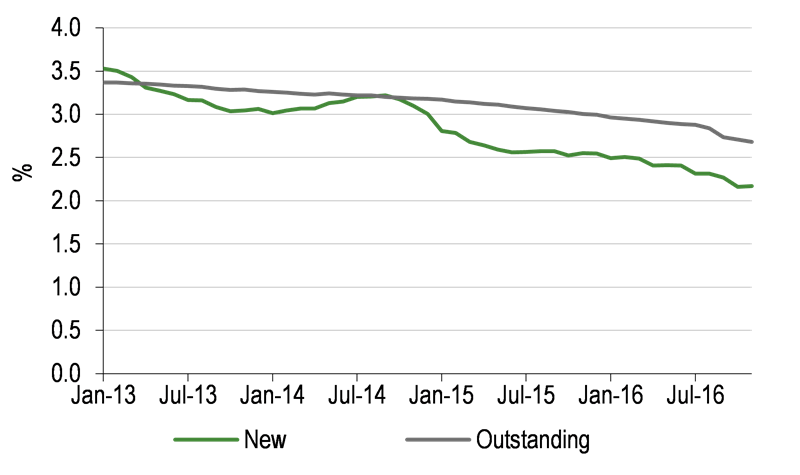We start by showing our revised assumptions for growth in loan book (Exhibit 14) with changes reflecting the 2016 outcome and updates from STB on its appetite for growth in each area. Running down the areas as listed in the table, we have made a somewhat more cautious assumption for STB’s mortgage lending in 2018 although note that, in the market context, the book would be very small on either assumption and the change has limited impact on our earnings estimate.
Reflecting a more cautious approach signalled for real estate and asset finance lending we have assumed numbers which, taken together are £200m and £250m lower than before for 2017e and 2018e, respectively.
We continue to look for good growth in the motor finance book and the group has indicated an interest in expanding its lending from non-prime to subprime, possibly employing a different brand to distinguish the offering. We expect that this will make a modest contribution to growth over the forecast period but could become significant subsequently if it were to gain traction. Changes in other areas are modest and for the total loan book our estimates are c £200m and c £270m lower for the two prospective years.
Exhibit 14: Loan book development estimates
£m |
2014 |
2015 |
2016 |
2017e |
2018e |
Personal unsecured |
88 |
74 |
66 |
33 |
0 |
Motor vehicles |
138 |
166 |
236 |
290 |
360 |
Retail finance |
117 |
220 |
326 |
410 |
520 |
Total retail lending |
342 |
460 |
628 |
733 |
880 |
|
|
|
|
|
|
Mortgage lending |
0 |
0 |
0 |
75 |
250 |
|
|
|
|
|
|
Real estate finance |
134 |
368 |
451 |
500 |
610 |
Asset finance |
5 |
71 |
117 |
103 |
195 |
Commercial finance |
5 |
29 |
63 |
150 |
200 |
Total commercial lending |
143 |
468 |
631 |
753 |
1,005 |
|
|
|
|
|
|
Other |
43 |
32 |
62 |
63 |
65 |
Discontinued |
94 |
114 |
0 |
0 |
0 |
Total lending |
623 |
1,075 |
1,321 |
1,624 |
2,200 |
Source: Edison Investment Research, Secure Trust Bank data
The lower loan book assumptions flow through to a lower interest income forecast for both years. STB expects competition to push up the market cost of funding marginally but expects to benefit from the launch of new savings products facilitated by the investment in a new IT platform, including a cash ISA; the bank will also make balanced use of the Term Funding Scheme. We have therefore assumed a slightly higher overall cost of funding over the forecast period.
Our operating cost estimates are lower than before for both years (an unchanged cost/income ratio for 2017 and a lower level for 2018 as some investment/launch costs are assumed to fall away).
Exhibit 15 summarises changes in our estimates for operating income, underlying PBT, EPS and dividends.
Exhibit 15: Estimate changes
|
Operating income (£m) |
Underlying PBT (£m) |
Underlying EPS (p) |
Dividend (p) |
Old |
New |
% chg. |
Old |
New |
% chg. |
Old |
New |
% chg. |
Old |
New |
% chg. |
2016 |
121.2 |
118.2 |
(2.5) |
31.9 |
32.9 |
3.1 |
141.0 |
137.7 |
(2.4) |
74.0 |
75.0 |
1.4 |
2017e |
142.3 |
141.0 |
(0.9) |
36.0 |
33.0 |
(8.3) |
155.1 |
140.8 |
(9.2) |
77.5 |
78.0 |
0.6 |
2018e |
173.6 |
168.3 |
(3.0) |
48.2 |
50.2 |
4.1 |
208.7 |
213.1 |
2.1 |
82.0 |
82.0 |
0.0 |
Source: Edison Investment Research. Note FY16 new figures are actual reported.
IFRS 9 will apply for FY18
It is important to remember that IFRS 9 will be implemented for reporting periods starting on or after 1 January 2018. This introduces significant changes to disclosure and recognition of credit losses. The standard divides financial instruments into three stages of credit quality. In the first, performing, category a 12-month expected credit loss will be recognised while for the second and third stages, comprising exposures where there has been a significant increase in credit risk or those where there is objective evidence of deterioration, an estimate of expected lifetime credit losses will be made. This is expected and intended to bring forward the recognition of credit losses.
Implementation is complex and is likely to require amendments to systems that not only change the accounting for credit exposures but also have a bearing on the systems used to support the underwriting process and therefore, potentially, the behaviour of some lenders.
We have no indication yet of the potential impact of the change on reported impairment (or other changes) for STB or its more immediate peers but assume that there will be a material increase in provisioning on adoption. In its impact assessment of IFRS 9 the European Banking Authority (EBA) carried out a survey of banks which indicated an average estimated increase in provisions of 18% and up to 30% for 86% of respondents.
It might be thought that earlier recognition of losses would allow a smoothing of credit losses, subject to implementation, although for the segment of loans where lifetime losses are assessed, assumption changes could still give rise to lumpy movements in impairments around turning points in the economic cycle. Indeed, in the EBA survey 75% of banks expect IFRS 9 impairment requirements to increase volatility in the profit and loss, mainly because of a cliff effect when there are moves from 12-month to lifetime expected credit loss estimates.
Turning to capital ratios, the EBA assessment indicated an estimated decrease in CET1 ratio of up to 75bp for 85% of respondents and 50bp in the total capital ratio for 75% of respondents.
Our estimates for FY18 are based on the current accounting standard but if we simply apply an 18% increase to the level of impairments for illustrative purposes, then this would result in a 13% reduction in FY18e profit. This would also reduce equity, return on equity and the CET1 ratio, subject to any taper approach adopted by regulators (again, note that our estimates are for the moment on the current basis). We stress that the impact for STB may differ substantially from the estimate derived from the EBA survey and also note that over time the impact on profits through the cycle would be expected to be less marked or neutral.

























